"My mother never worked out of the home, although she did perform as a community theatre actress when I was younger (no pay, of course). Back in those days, that was the norm: father worked, mother was a stay at home mom. We did not lead a lavish lifestyle but it was good. We were provided for and my parents were able to afford a few toys and at least one vacation a year."

"Pop would have been 41 years old when he married Mimi, so I'm sure he must have spent a number of lean years in his younger day. He never talked about that, though."
"I wish I could tell you I had memories of the outline of Denver's early life. Although he talked about his career as an illustrator, I remember most his ability to tell a good story and I loved to hear him talk about his childhood and his early days as an artist. The "facts" that I relate to you, however, come from a wonderful article about Denver Gillen written by Norman Kent in the November 1956 issue of American Artist."
"I am telling you this so that you will understand the following: Pop couldn't have children of his own. He had been hospitalized at age seventeen with a prolonged illness that made it impossible for him to have children."
"But, his time in the hospital changed the direction of his life."
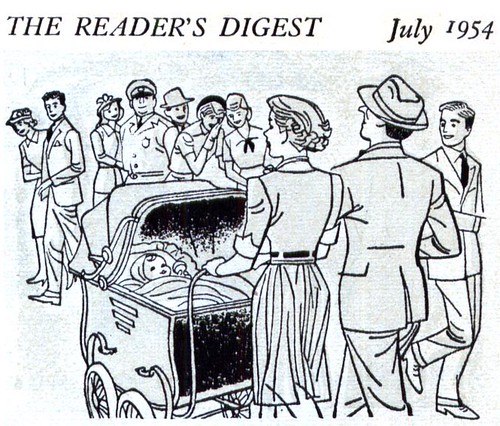
"It was while in the hospital that he was encouraged to pass the time by drawing, by his doctor who was an amateur artist. Pop had been raised in a seafaring family in Vancouver, BC and would have probably followed his father and brothers into some related form of work. By the time he left the hospital, however, he knew he wanted to become a commercial artist."
"According to that article, "his doctor arranged a meeting with the manager of the art department of the Hudson Bay Company and there Gillen stayed for three years, learning the basic techniques of commercial studio." During that time, he met Edward Varley and studied with him. Then, Denver moved to Toronto in 1935 and worked for a year in the Brigden Studios. When commercial artists went on strike, he moved to Chicago. He worked for Montgomery Ward for four years as a staff artist, where he did the original illustrations for "Rudolph the Red-Nosed Reindeer", their gift to their customers. He then worked for another six years in Chicago in a "variety of studio affiliations".
"When Pop moved his studio to the new attachment to the house, I started working with him, part-time after school. I loved it! You entered the studio from the living room through the "plant room" that separated the spaces. The plant room was loaded with exotic plants, trees, shrubs and flowers. Our parrot, Lora, dictated policy as one walked through, screeching and whistling and laughing. The studio was quite large and a picture window overlooked the backyard and the lake. There was Pop's drawing board and his side table for his paints. Also an area he called "the morgue" where I worked, pouring through endless magazines like National Geographic and countless others, pulling out a billion photographs and illustrations to be sorted and catalogued according to subject. Also, I clipped tear sheets of his work and filed those, too. There was also a dark room and an overhead projector where Pop viewed reference material for whatever illustrations he was working on."
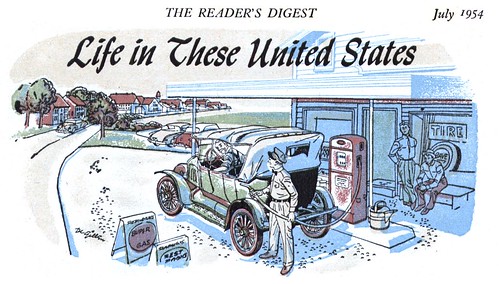
"Pop was a natural promoter of his own work. He never had an agent, to the best of my knowledge. He had no fear, although he wasn't an arrogant man. I think his early years of struggle, of trying to help support his mother after his father died and supporting himself as a young man, kept him on the prowl for work. He could do a variety of things, as [an] article by Norman Kent in American Artist of November 1956 points out. He made contacts and befriended a wide variety of people in the art world. "Networking", we call it now. One or two times a month, he would drive to New York City and pound the pavement, renewing contacts and foraging for new ones. He always stopped into the Society of Illustrators, too. I remember going with him a few times. I loved, especially, going to the Society of Illustrators and being served a "Shirley Temple" by a white gloved black butler. I was very shy, but this was a lovely and special treat for me."
"The Norman Kent article will give you more information about Pop at that time. Kent was the original person to hire Denver for the Reader's Digest. I remember seeing Pop doing those illustrations. He did the line drawings then did acetate overlays for the color(s). It was a pretty basic process. I did this sort of thing, too, when I worked for the offset printer doing graphics, typesetting, and color separations. I guess the Digest had their illustrators do their own separations, which makes sense."
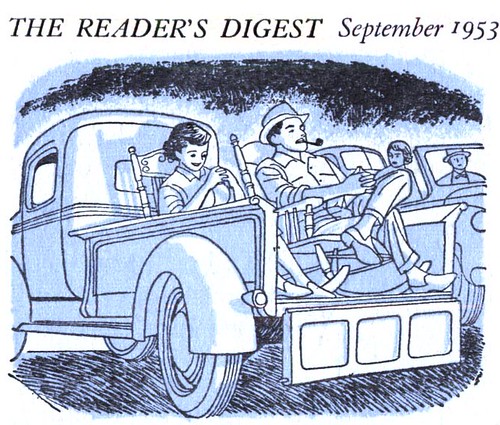
"There was a daybed [in the studio] where Mimi would sit and read to Pop. Both she and Pop were avid readers, but, it was Mimi, trained in speech in college, who loved to read out loud an assortment of novels while Pop worked. Pop would get up early in the morning and head for the studio. He listened to talk radio, I remember, laughing out loud at William B. Williams and other humorous commentators. Then my mother would go in a do some reading, after finishing her own chores. And, I would hang out there, too, a few afternoons a week and tend to the morgue. After I left home for Boston University, my across the street friend took over my duties. (Funny thing there, too; I also worked occasionally for her father, filing flight plans in his pilot manuals.) The cool thing about my father, he had an open door policy -- no knocking necessary. He had an amazing ability to concentrate."
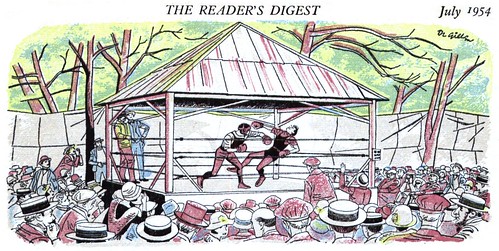
"However, there were times when he was under extreme deadlines -- you know the drill -- and we just knew when it was better to stay away."
"I tried to follow in Pop's footsteps, but, truly, I never had the burning desire to be an artist, and especially an illustrator. Too much pressure! I think if Pop had been a lawyer, I would have gone to law school, and I would have been successful because I have that kind of mind."
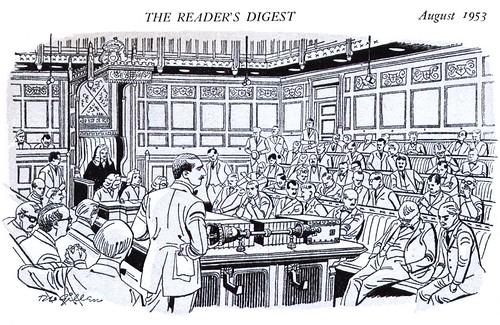
"But, I was a daddy's girl and wanted to be like him."
Continued tomorrow...
Denver Gillen Flickr set.
it’s a pleasure keep reading this kind of histories about illustrators
ReplyDeleteRegards
Barbara Bradley asked me to post this comment on her behalf:
ReplyDeleteWhat a pleasure it was to read the account of Denver Gillen's career through the eyes of his daughter. I think both were fortunate; She to have good memories of interesting and neat parents and he to have had some one to handle his"Morgue", a fascinating but enormous task. Gillen's work shows his interest in getting things just right: figure attitudes, clothing, architecture, whatever the topic took. Though their styles were very different, Gillen's willingness and ability to include so much architectural background reminds me of Fawcett. I particularly admire that ability. Had it been a prerequisite of illustration to be able to dash off a scene from Parliament, I doubt if I could have become an illustrator. Thank you for taking the time to share one more skillful and admirable illustrator with us.
Barbara Bradley
Memoirs like this are extremely touching and a joy to read. Leif
ReplyDeletethis blog provides such a wonderful window into the lives of these wonderful men and women of the art world. Jenifer's stories along with her father's terrific pieces was
just great. My favorite is easily the couple sitting in the back of the pick-up truck. Thanks ever.
Thanks for that, Ron - its good to hear that these posts bring as much pleasure to others as they do to me - I feel very privileged to be able to provide a venue for such wonderful stories - and grateful to great folks like Jen, who are willing to share them with us!
ReplyDelete